 Parasite Primer ... continued
Parasite Primer ... continued
 NEMATODES - There are nearly
20,000 species of nematodes. Their ubiquitousness makes "nematology"
one of the largest areas of parasite study (parasitology).
The photo at left was taken from the web page on the BioScience section
of Ohio State devoted to
Ascaris
lumbricoides (intestinal roundworms), the largest and most common parasite
found in humans. NEMATODES - There are nearly
20,000 species of nematodes. Their ubiquitousness makes "nematology"
one of the largest areas of parasite study (parasitology).
The photo at left was taken from the web page on the BioScience section
of Ohio State devoted to
Ascaris
lumbricoides (intestinal roundworms), the largest and most common parasite
found in humans.
 To prevent redundancy, we
provide the following links to those who want more information on
the nematode class. We will discuss how to identify nematodes
at various stages in stool samples in a moment. To prevent redundancy, we
provide the following links to those who want more information on
the nematode class. We will discuss how to identify nematodes
at various stages in stool samples in a moment.
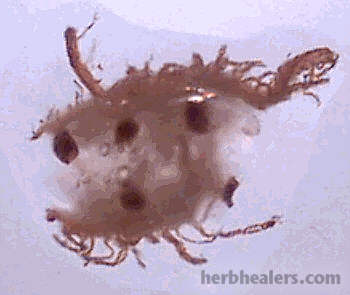 What To Look For
What To Look For
 The specimen above was shot at
200X. Medical doctors are trained to look for
eggs when nematode infectation, particularly with common types such as
intestinal worms (i.e. ascaris). Those without any training are most
likely to focus on adults, because these are easiest to stop as an
anomoly. Although people who use Dewormer will frequently
find adult parasites in the stool sample - the most commonly found
specimens are eggs and intermediate stages in the reproductive
cycle. The specimen above was shot at
200X. Medical doctors are trained to look for
eggs when nematode infectation, particularly with common types such as
intestinal worms (i.e. ascaris). Those without any training are most
likely to focus on adults, because these are easiest to stop as an
anomoly. Although people who use Dewormer will frequently
find adult parasites in the stool sample - the most commonly found
specimens are eggs and intermediate stages in the reproductive
cycle.
 Incredibly common are small
groupings of nematodes that look like little pieces of white bread
that have been rolled up -- off-white, puffy or spongy in appearance,
and thread-like on close inspection. Incredibly common are small
groupings of nematodes that look like little pieces of white bread
that have been rolled up -- off-white, puffy or spongy in appearance,
and thread-like on close inspection.

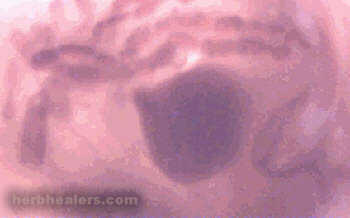 Reproductive Systems
Reproductive Systems
 At 200X you can bring out details
in a specimen that cannot be seen with the naked eye or lower levels of
magnification. In the photo above, the reproductive system of a fluke
is made clearly visible. Many times parasites look like nothing more
than a glob. If you can magnify them enough and search for a large
glob, sometimes you can find the reproductive system. In this picture,
the eggs were washed off and at 200X, at which point it was obvious
that the specimen was a parasite. Parasites only have one goal,
making babies in YOUR body! At 200X you can bring out details
in a specimen that cannot be seen with the naked eye or lower levels of
magnification. In the photo above, the reproductive system of a fluke
is made clearly visible. Many times parasites look like nothing more
than a glob. If you can magnify them enough and search for a large
glob, sometimes you can find the reproductive system. In this picture,
the eggs were washed off and at 200X, at which point it was obvious
that the specimen was a parasite. Parasites only have one goal,
making babies in YOUR body!
|
By Their Eggs Ye
Shall Know Them
 Above: In actuality, without
genetic testing you can't identify the species of parasite from
a sampling of eggs taken from a stool sample, but you can sure
identify their presence. The sample above, taken at 200X
was a young woman. Interestingly, parasites reproduce in
many different ways. Some lay egg masses; some divide and
break off; some lay strings of eggs similar to frogs or other
amphibians. Some stay attached until mature enough to swim
away. Parasites have many stages before reaching adulthood --
each stage has its own characteristics and the organism
manifests a different morphology.
(Click picture above
to enlarge.) Above: In actuality, without
genetic testing you can't identify the species of parasite from
a sampling of eggs taken from a stool sample, but you can sure
identify their presence. The sample above, taken at 200X
was a young woman. Interestingly, parasites reproduce in
many different ways. Some lay egg masses; some divide and
break off; some lay strings of eggs similar to frogs or other
amphibians. Some stay attached until mature enough to swim
away. Parasites have many stages before reaching adulthood --
each stage has its own characteristics and the organism
manifests a different morphology.
(Click picture above
to enlarge.)
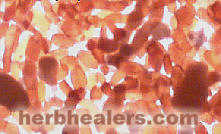 A Sea of
A Sea of
Unhatched Eggs
 The picture above was taken
within days after a customer began using Dewormer. Identification
could be tough in this situation. How many of these eggs would
yield pathogenic trematodes or nematodes? Does it really matter?
The point is ... they didn't belong inside this person -- and
now they've been expelled.
[Click to
enlarge.] The picture above was taken
within days after a customer began using Dewormer. Identification
could be tough in this situation. How many of these eggs would
yield pathogenic trematodes or nematodes? Does it really matter?
The point is ... they didn't belong inside this person -- and
now they've been expelled.
[Click to
enlarge.]
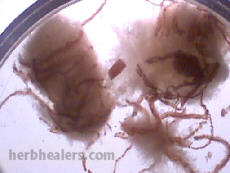 Spiders & Cotton Balls
Spiders & Cotton Balls
 Two structures you want to watch for
are "spiders" - more common with trematodes, but clearly indicative
of parasites. The other structure is "cotton balls," or what some
appear to be fluffy, rolled up pieces of fur. If you've ever taken
white bread to the park to feed ducks, you know what the bread
looks like on the surface of the pond water. There is no food
you can eat that will yield this low-density kind of structure
in the stool. Two structures you want to watch for
are "spiders" - more common with trematodes, but clearly indicative
of parasites. The other structure is "cotton balls," or what some
appear to be fluffy, rolled up pieces of fur. If you've ever taken
white bread to the park to feed ducks, you know what the bread
looks like on the surface of the pond water. There is no food
you can eat that will yield this low-density kind of structure
in the stool.
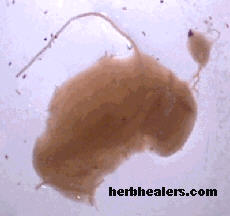 More 'Cotton Balls'
More 'Cotton Balls'
 Most physicians would miss this
because it doesn't take on either the gross adult structure of
ascaris lumbricoides you see at top of this page, or
the huge egg cluster they are trained to spot when the
nematodes themselves have moved well beyond their asymptomatic
stages of activity in the host. But a really good colon
hydrotherapist would never miss it. Most physicians would miss this
because it doesn't take on either the gross adult structure of
ascaris lumbricoides you see at top of this page, or
the huge egg cluster they are trained to spot when the
nematodes themselves have moved well beyond their asymptomatic
stages of activity in the host. But a really good colon
hydrotherapist would never miss it.
 The first bowel movement
in the morning following a thoroughly hydrotherapy session is usually
quite watery. That is usually when these puppies usually make
their grand entrance. The first bowel movement
in the morning following a thoroughly hydrotherapy session is usually
quite watery. That is usually when these puppies usually make
their grand entrance.
Next Page
|





